Kutschera
SS-Obergruppenführer Wilhelm Koppe was a completely disgusting figure. At the turn of the 1920s and 1930s, he became involved with the Nazis and quickly made a career in the SA and SS. After the creation in October 1939 of the Warta Country - encompassing the western territories of the Second Polish Republic incorporated into the Third Reich - he became the head of the local apparatus of repression.
While performing his function for four years he proved to be a ruthless enemy of everything that is Polish . No wonder then that when in November 1943 he replaced Friedrich Krüger, who was in conflict with Himmler, in the position of the Higher SS and Police Commander in the GG, the Home Army almost immediately sentenced him to death.
How about a job for a sniper?
The original plan was that it would be eliminated by a sniper. Cichociemny, lieutenant Ryszard Nuszkiewicz "Slow" was selected as the executor of the attack. It was supposed to take a shot from the turret of a tenement house at the corner of Bernardyńska and Smocza Streets, located about 250 meters from the Wawel Hill, where Koppe lived.
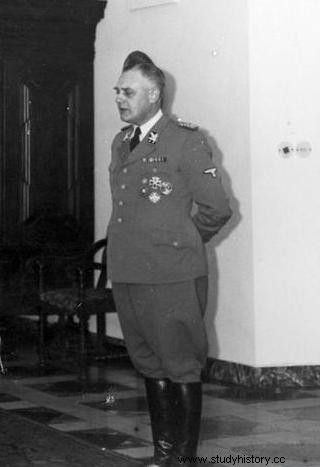
SS-Obergruppenführer Wilhelm Koppe in one of the chambers of the Royal Castle in Krakow. The photo was taken less than a month before the attack.
Although the plan had a good chance of success, it was eventually abandoned. Two factors were decisive. First, there was fear of bloody reprisals against the inhabitants of the sub-Wawel district.
Second, such an attack was of little propaganda value. Even if Koppe died, the Germans could simply cover up the whole matter in the world. And the psychological effect of the whole enterprise would be none.
Therefore, at the turn of 1943 and 1944 it was decided that Koppe would be killed in a more "traditional" way . However, in order to do so, first you had to know the schedule of Obergruppenführer and the routes on which he traveled from Wawel to the seat of the "government" of the General Government, located in the building of the pre-war AGH University of Science and Technology (the current AGH University of Science and Technology).
The head of communications in the Kedyw District of Krakow, Józef Baster "Rak" and his people quickly realized that the Nazi criminal was moving around the city in a renovated and repainted 12-cylinder Mercedes, previously owned by Krüger. The problem of establishing "home-work" access routes was a bit more problematic. The reason for this was Koppe's caution, which only increased after the attack on Franz Kutschera.
Nevertheless, the increased observation carried out by the liaison officers of the Home Army and the navy blue policemen cooperating with the underground brought good results. However, the situation suddenly changed in March 1944 after the Germans arrested Józef Spychalski, the commander of the Home Army Kraków Unit, "Lutego".
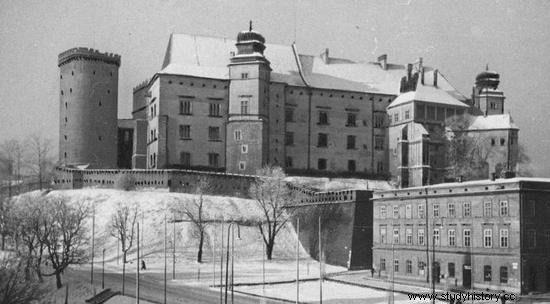
Initially, the plan to assassinate Koppe assumed that he would be shot by a sniper as he got into a car in the courtyard of the Wawel Royal Castle, where he lived. Ultimately, the command of the Home Army decided on a different variant.
Its reflection - which ultimately did not happen - became a priority. As a result, the attack on the Nazi dignitary was pushed to the background. It was only returned to it after a few weeks, but now the "Parasol" battalion from the Warsaw Kedyw was to be responsible for its execution.
"Umbrella" enters the game
It was a formation created especially for this type of action. It was the soldiers of the "Umbrella" who on February 1, 1944 liquidated SS-Brigadeführer Franz Kutschera, now they have been tasked with sending Koppe into that world .
The first to come to Krakow was the intelligence chief of the branch, Aleksander Kunicki "Rayski", in order to organize a re-observation of the German. As he had already cooperated with the Kraków Home Army, he quickly made contact with Feliks Grochal "Warecki", a criminal police officer, providing him with guidelines regarding the operation "Koppe".
Meanwhile, in Warsaw, the commander of "Parasol", Adam Borys "Pług", wondered who to entrust the management of the entire operation. Ultimately, the choice fell on the 1st company, headed by Stanisław Leopold "Rafał", who had just replaced the fallen Bronisław Pietraszewicz "Lot".
In the second half of May, he went to Krakow, where he arranged the details of the accommodation of his people, weapons warehouses and garages, as well as carried out a reconnaissance of possible ways of retreat after the attack. Finally, deciding to go north, through Ojców, Skała, Wolbrom and the vicinity of Żarnowiec.
After the initial preparations had been made, a plan was developed for the transfer of weapons and cars to the "capital" of the General Government. After the attack on Kutschera, the Germans tightened their control considerably.
Introduced, among others an obligation to have passes for vehicles traveling longer than 100 km. Ultimately, we managed to obtain the necessary forms and five cars - three passenger cars and two trucks - left for Krakow.
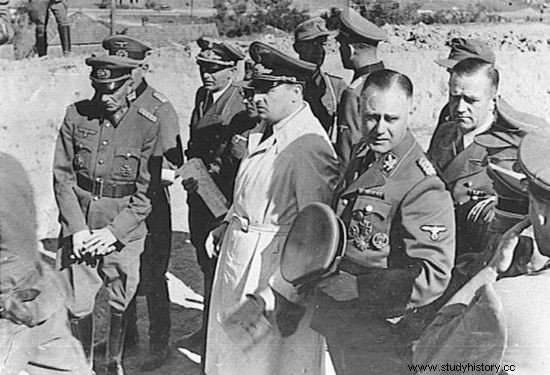
Wilhelm Koppe proved to be a staunch enemy of Poles. He had numerous crimes on his conscience, both in the Warta Country and in the General Government. In the photo (he is holding a cap in his hand) with Governor General Hans Frank (in a pale coat).
The weapon, in turn, was shipped by rail. It is hidden in empty cable joints, old starters and force meters. In order not to arouse any suspicions, German consignment notes were used. In the last week of June, the remaining soldiers of "Parasol", taking part in the action, gradually began to descend to the city of Krak. There were supposed to be over twenty of them.
In Krakow itself, work was in full swing. Koppe was subjected to close observation, which resulted in the determination that he always leaves Wawel between 8:30 and 9:30. The problem, however, was that he used several alternative routes to reach the building of the former Mining Academy. In addition, from time to time he changed cars, and during the passage he was accompanied by an aide, as well as a bodyguard of several Gestapo men riding in the other vehicle.
After analyzing the situation, it was decided that the best place to carry out the attack would be Kossaka Square at the end of Powiśle Street . The attack was to be carried out by two strike groups and two policyholders. In total - including car drivers and the reserve - it was 20 soldiers.
There are also six liaison officers responsible for the diagnosis of "Rayski", and Dr. Zbigniew Dworak "Dr. Maks", head of the sanitary group "Parasol".
Where is the bodyguards?
When the plan was ready, all that was left to do was to wait for the opportune moment. The first attempt was made on Wednesday 5th July, but Koppe chose a different route that day . Undaunted by this, the Home Army soldiers waited for him again two days later, but this time Koppe did not leave Wawel at all .
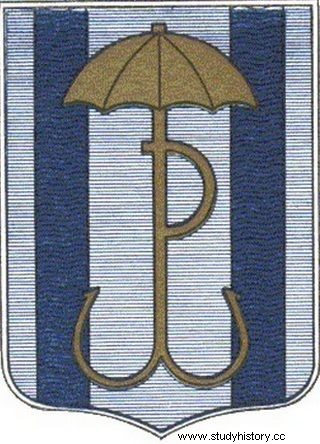
Badge of the "Parasol" battalion.
The re-cancellation of the action had a depressing effect on the members of the branch. One of them - Zdzisław Poradzki "Kruszynka" - recalled:
With downcast eyes we go back to the den. The boys' faces are more than sour. Force majeure - apparently it is destined for us to see Krakow better and delay our return to Warsaw. Everyone has had enough of this. Two weeks have almost passed and we are at a standstill and it is not known how long we will be sitting here.
The third - and as it turned out the last - approach to the attack was scheduled for July 11. This time S S-Obergruppenführer at 9:17 he actually started towards Kossak Square, which he reached after a few minutes. That day - exceptionally - he was not accompanied by a security car, which was simply late. Paradoxically, this may have caused the entire operation to fail.
It happened because the signal to block Koppe's Mercedes was to fire at the guards' car. The absence of it confused the Home Army for a moment. As a result, the drivers of the SS and Police High Commander managed to avoid a truck trying to cut his way, and then at high speed drive away from the ambush site.
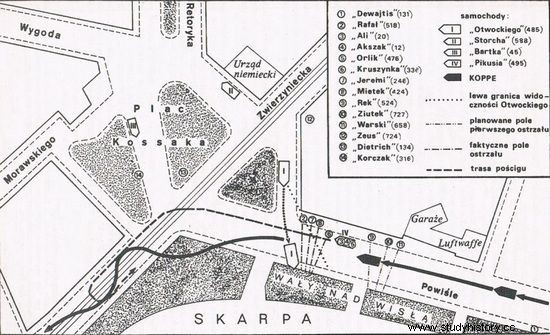
A sketch showing the course of the assassination attempt on Koppe. The sketch comes from the book by Piotr Stachiewicz, "» Parasol «". The history of the Division for Special Tasks of the Diversion Management of the Home Army Headquarters ”, PAX Publishing Institute 1984.
The akovians, of course, opened heavy machine gun fire at the car passing by. However, Koppe showed good reflexes, throwing himself immediately to the floor of the armored limousine, which saved his life. On the other hand, Captain Hoheisel, who was hit by Polish bullets, was less fortunate that day . One of the Home Army soldiers was also injured - Antoni Sakowski "Mietek", who received a minor shot in the hand.
Tragic road to Warsaw
The whole action lasted only a few dozen seconds and after it was completed, there was a quick jump along the previously established route. The column of 4 cars - one of the Mercedes passenger cars broke down - initially headed towards Warsaw without any problems. Unfortunately, behind Wolbrom there was a clash with the encountered gendarmes.
Eugeniusz Schielberg "Dietrich" was seriously wounded during the fight. German losses amounted to two killed and one wounded. After this event, the small convoy continued its route, finally reaching the village of Udórz, where "Rafał" ordered a half-hour stop in order to find a safe shelter for "Dietrich".
At that time, the Germans reappeared. This time they had a significant advantage over the Home Army. Deputy commander Stanisław Huskowski "Ali" and Wojciech Czerwiński "Orlik" fell in an unequal fight. The injured were Stanisław Leopold "Rafał", Jerzy Kołodziejski "Zeus", Bogusław Niepokój "Storch", Tadeusz Ulankiewicz "Warski" and Halina Grabowska "Zeta".
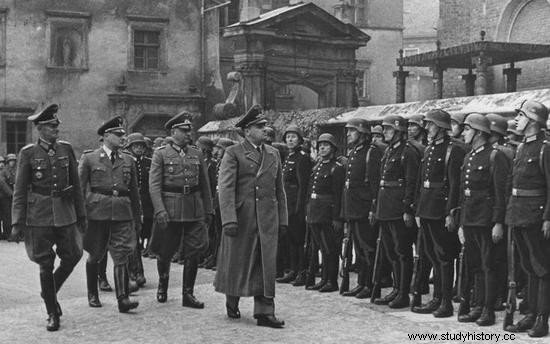
A lot of luck and a quick reaction meant that Koppe left the coup unscathed and held his office until the end of the General Government. Pictured (second from left) during the fifth anniversary celebration (October 1944).
The last three fell into German hands and were later tortured in order to extract information about the remaining participants in the attack. However, they did not betray anyone and were eventually murdered by the Germans.
After the unsuccessful action of the soldiers of "Parsol", Lieutenant "Slow" was going to make one more attempt to kill Koppe, planning to throw grenades at his car.
In the end, nothing came of it, due to the transfer of - promoted to captain - Nuszkiewicz to Miechowskie. Koppe himself died a natural death on July 2, 1975. He has never been tried for his numerous crimes.
You can read about other spectacular actions of the Polish independence underground in the "Great Book of the Home Army".
Bibliography:
- Monika Bednarek, Edyta Gawron, Grzegorz Jeżowski, Barbara Zbroja, Katarzyna Zimmerer, Kraków under occupation 1939-1945 , Historical Museum of the City of Kraków, 2010.
- Andrzej Chwalba, Occupation Krakow in 1939-1945 , Wydawnictwo Literackie 2011.
- Stanisław Dąbrowa-Kostka, In occupied Krakow. September 6, 1939 - January 18, 1945 , Publishing house of the Ministry of National Defense 1972.
- Zygmunt Niepokój, Action "Koppe" , [in:] Dynamit, part 2, Wydawnictwo Literackie 1967.
- Piotr Stachiewicz, "Umbrella". The history of the Special Tasks Division of the Diversion Directorate of the Home Army Headquarters , PAX Publishing Institute 1984.
